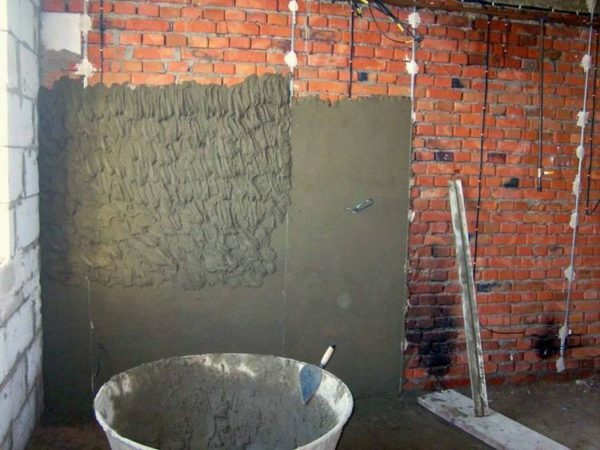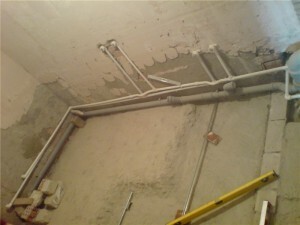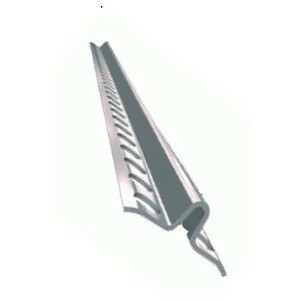Consumption of cement in the plaster: do yourself solution
Table of contents
-
1 classification of formulations
- 1.1 Preparation of the solution
- 1.2 Tips masters
- 2 Ready plasters
- 3 Cooking Tips plaster
- 4 Output
Interior decoration is often applied plasters based on cement binder. To obtain a quality cover is important to correctly identify the consumption of cement in the plaster. But first consider what a mortar.
It consists of a binder material which acts as cement, aggregate - sand and water.
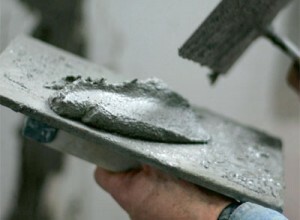
Depending on the type of finish in the cement slurry can be introduced various additives which give it additional properties:
- plastic;
- rapid or retardation;
- resistance to aggressive environments;
- heat resistance;
- frost.
Conventional solutions have different compositions:
- Cement - Part 1;
- sand - 1 to 6 parts.
classification of formulations
Depending on the amount of binder solutions were divided into:
- Fatty. Contain a lot of cement, give a strong shrinkage and crack easily.
- Skinny. They contain a lot of filler and a little cement, do not shrink and crack.
- Normal. Have the optimum ratio of the binder and filler.
According to the density divided into:
- heavy, density of 1500 kg / m³ and more;
- lungs, density 1500 kg / m³.
The average density of the plaster in the hardened state is 1600-1800 kg / m3.
For the walls with his own hands indoors most common solutions are cement-lime. They are made with the addition of lime paste have high strength and good adhesion.
Preparation of the solution
Instructions:
- dry blend of 1 part cement and 3-5 parts sand thoroughly mixed;
- lime paste is diluted in water to a liquid state;
- dry mixture is mixed to the desired density of milk of lime.
Before starting the repair should calculate materials for plastering. To do this, you need to know the surface area and thickness of the layer.
If you have straight walls, the layer thickness will be the same at different sites. In this case, to calculate the flow rate is easy.
For example:
Layer thickness: 2 cm or 0.02 m.
Surface area: 50 m².
Consumption per 1m²: 1h1h 0.02 = 0.02 m³, and since a 1-m³ -1000 liters, then 20 liters = 1000h0,02.
Flow 50 m²: 50h20 = 1000 liters or 1 m³.
If you are using cement-sand mass in the ratio of 1: 3.
Then:
Cement per 1 m² - 0.005 m³ respectively 50 m² - 0.25 m³.
Sand 1 m² - 0.015 m³ respectively 50 m² - 0.75 m³.
If you use a cement mortar in a ratio of 1: 1: 6 (cement, lime, sand).
Then:
The amount of cement per 1 m be 0.0025 m³, respectively 50 m² - 0.125 m³.
The amount of lime test 1m² -0.0025 m³, respectively 50 m² - 0.125 m³.
The amount of sand per 1 m² - 0.015 m³ respectively 50 m² - 0.75 m³.
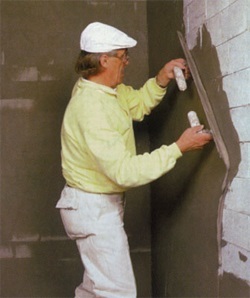
The photo application of the mass on the wall
Tips masters
Counting consumption of materials, consider the following factors.
1. the curvature of the walls.
If the walls have a deviation from the vertical, to calculate the flow rate is more complicated. For this it is necessary to determine the minimum and maximum thickness of the intended layer.
Example:
The minimum thickness - 10 mm.
Maximum thickness - 30 mm.
We compute the average value: (10 + 30) 2 = 15 mm.
We calculate the flow method described above with a layer thickness of 15 mm.
2. Parallel to the wall and correct angles (90º).
The easiest way to calculate the consumption of plaster on 1m² with these factors in mind, if we carry out plastering beacons surface. Exposing beacons according to technical requirements, it is necessary to measure the maximum distance from the beacon to the work surface, and to calculate the average layer.
Ready plasters
Dry weight are sold in finished form and packaged in bags. Consumption of dry mix plaster execute much easier, as already stated on the packaging data.

Dry mixture (the price - from 295 rubles).
Setting the beacons on the surface, it is easy to determine whether the differences in thickness that is specified by the manufacturer. Based on these data and footage surface should calculate the amount of the dry mixture. To determine the exact amount of material for plaster beacons does not work, but manage to avoid mistakes in the ten kilogram.
Important! Selection of dry weight depends on what you are going in the future be applied or glued to the surface. Brand dry mixture should correspond to the type of material deposited on it.
Cooking Tips plaster
- Before preparing all bulk materials need to sift through a sieve with cells 3x3 mm.
- Lime, milk of lime is prepared by mixing the required amount of lime and water.
- Containers in which the mass will get involved must be clean and dry.
- Cement and sand are thoroughly mixed until a homogeneous mass of color.
- The dry weight and the recess is filled with water or milk of lime.
- Gradually via paddles mixture crater edges discharged into water and stirred to obtain a homogeneous composition the desired consistency.
- At the bottom and in the corners of the container should not be unmixed particles.
Important! The normal solution is slightly adheres to the oar. Skinny solution does not adhere to the oar, the cement should be added to it. Bold - adheres strongly, it is necessary to add sand.
For cement and lime plaster masses accepted designation, which is received per unit cement, the proportion of other components are indicated with respect to cement.
For instance:
Cement - 1: 2 - represents one part cement and two parts of sand.
Cement-lime - 1: 1: 6 - cement, lime and sand.
Plastering cement mortars can be carried out on the rough, cellular concrete, masonry, wood and shlakoblochnogo surface of old plaster.
Output
We hope our stuff was useful for you, we also need to wish you good luck, and to offer the video in this article.
